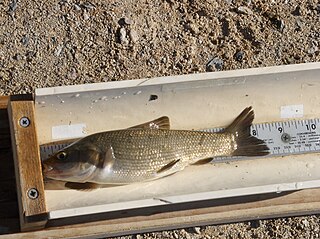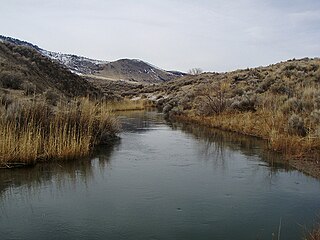
The Mohave tui chub is a subspecies of the tui chub endemic to the Mojave River.

Lahontan cutthroat trout is the largest subspecies of cutthroat trout, and the state fish of Nevada. It is one of three subspecies of cutthroat trout that are listed as federally threatened.

The Sacramento blackfish is a species of freshwater fish in central California. A cyprinid, the blackfish is the sole member of its genus.

The chiselmouth is an unusual cyprinid fish of western North America. It is named for the sharp hard plate on its lower jaw, which is used to scrape rocks for algae. It is the sole member of the monotypic genus Acrocheilus and is a close relative of the Gila western chubs, and is known to hybridise with Ptychocheilus oregonensis.
The Alvord chub is a rare cyprinid fish endemic to the Alvord basin in southeastern Oregon and northwestern Nevada, U.S., known only from a few springs, streams and marshes in the Sheldon National Wildlife Refuge, and one location elsewhere.

The Utah chub is a cyprinid fish native to western North America, where it is abundant in the upper Snake River and throughout the Lake Bonneville basin.

The Borax Lake chub is a rare cyprinid fish found only in outflows and pools around Borax Lake, a small lake of the Alvord basin, Harney County, Oregon.

East Lake is one of the twin lakes that occupy part of the Newberry Crater or caldera in Central Oregon, United States. It is located in the Deschutes National Forest near the city of La Pine. The caldera was formed over 500,000 years ago from volcanic eruptions. East Lake's water comes from snow melt, rainfall, and hot springs only. The average depth is 67 feet (20 m), 180 feet (55 m) at the deepest point, and covers 1,044 acres (4.2 km2). East Lake is about 50 feet (15 m) higher in elevation and is to the east of its twin, Paulina Lake.
Bothriocephalus acheilognathi, also known as the Asian tapeworm, is a freshwater fish parasite that originated from China and Eastern Russia. It is a generalized parasite that affects a wide variety of fish hosts, particularly cyprinids, contributing to its overall success.

The Ana River is a short spring-fed river in south-central Oregon. It is on the northwestern edge of the Great Basin drainage. It flows 7 miles (11 km) from springs at the foot of Winter Ridge through high desert, range, and wetlands before emptying into Summer Lake. For most of its course, the Ana River flows through the Summer Lake Wildlife Area, which is maintained by the Oregon Department of Fish and Wildlife. The river provides habitat for many mammal and bird species, as well as several fish species, including the rare Summer Lake Tui chub. The largest hybrid striped bass ever caught in Oregon was taken from Ana Reservoir in 2009.

The Summer Lake Wildlife Area is a 29.6-square-mile (77 km2) wildlife refuge located on the northwestern edge of the Great Basin drainage in south-central Oregon. It is administered by the Oregon Department of Fish and Wildlife. The refuge is an important stop for waterfowl traveling along the Pacific Flyway during their spring and fall migrations. The Summer Lake Wildlife Area also provides habitat for shorebirds and other bird species as well as wide variety of mammals and several fish species. The Ana River supplies the water for the refuge wetlands.
The Death Valley freshwater ecoregion is a freshwater ecoregion in the western United States. It consists of endorheic rivers, lakes, and springs in the drainages of the Owens, Amargosa, and Mojave Rivers, in central-eastern California and southwestern Nevada.
Stillwater Marsh is an archaeology locality in the Carson Sink in western Nevada discovered when heavy flooding in the 1980s unearthed many human remains. The great diversity in plant life and altitudinally-determined microenvironments that surrounded the marsh helped to make it a popular place to live, as evidenced by archaeological findings. At Stillwater Marsh, skeletal remains were the primary means used to determine how people lived in the area. As large numbers of skeletons had not previously been found at Great Basin sites, Stillwater Marsh offered a remarkable opportunity to learn about daily life, as reflected in the human remains.
Catherine "Kay" S. Fowler is an anthropologist whose work has focused on preserving the cultures of the native people of the Great Basin. She earned her PhD from the University of Pittsburgh, and from 1964 to 2007 taught at the University of Nevada, Reno, where she is now Professor Emerita.
Siphateles is a genus of fish belonging to the family Cyprinidae, native to the Western United States. They were formerly placed in the genus Gila.

The Klamath smallscale sucker(Catostomus rimiculus), also known as the Jenny Creek sucker, is a species of ray-finned fish in the family Catostomidae. It is a freshwater fish that primarily inhabits the Trinity and Klamath River watersheds, as well as the overall region of the Klamath Basin in general. Within the Klamath Basin, they inhabit the area along with three other sucker fish: the Lost River sucker, shortnose sucker, and the Klamath largescale sucker. These fish can vary in length from 35 cm to 50 cm, and usually have a lifespan of around 9-15 years. They often form mixed schools with speckled dace, sculpins, and juvenile steelhead.

The Owens tui chub was described in 1973 as a subspecies of tui chub endemic to the Owens River Basin in Eastern California, United States. The Owens tui chub is distinguished from its closest relative, the Lahontan tui chub, by scales with a weakly developed or absent basal shield, 13 to 29 lateral and apical radii, also by the structure of its pharyngeal arches, the number of anal fin rays, 10 to 14 gill rakers, and 52 to 58 lateral line scales. Dorsal and lateral coloration varies from bronze to dusky green, grading to silver or white on the belly. It may reach a total length of 30 centimetres (12 in). Owens tui chub are believed to be derived from Lahontan Basin tui chub that entered the Owens Basin from the north during the Pleistocene Epoch.

San Mateo Rocks are uninhabited islands that lie approximately 0.5 mi (0.80 km) off the coast of California, to the south of San Clemente, and just north of San Mateo Point, a minor headland that marks the border between Orange County and San Diego County. The rocks rise about 3 ft above high tide. In 2017 the San Mateo Rocks, a pinniped haul-out and scuba destination, became part of the California Coastal National Monument.













